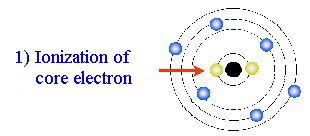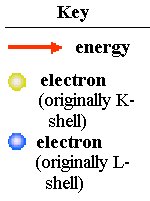Auger Spectroscopy is a method used to determine the composition of the surface layers of a sample. There are three steps:
- atom is ionized by removing a core electron,
- upper level electrons falls to a lower level,
- third electron (Auger electron) is excited by the energy given off in step 2 and detected. The atom is left with two vacancies.
The same optics used for LEED are used for AES. The electron gun shoots a beam of electrons at the sample. The grids and screen now act as a collector for the Auger and secondary electrons returning from the surface. The negative potential (Ur) applied to two of the grids is ramped from Umax to zero, and the screen (which is biased positive) collects the current. That current is proportional to the integral of the energy distribution (N(E)) of the electrons from the surface of the sample. The signal must be differentiated to find the energy distribution. A small oscillating voltage (Um sin(wt)) is applied to the repeller grids making the collector currenti(Ur + Um sin(wt)) which can be expressed as a Taylor expansion:
i(Ur + Um sin(wt)) = i(Ur) + i’(Ur) Um sin(wt) + (i’’(Ur)/2) U2m sin2(wt) + …
The second term is proportional to the energy distribution and varies as sin(vt). The lock-in amplifier reads the current, receives the frequency from the reference signal (from the oscillator), and isolates the energy distribution (the second term). The third term is proportional to the first derivative of the energy distribution.




